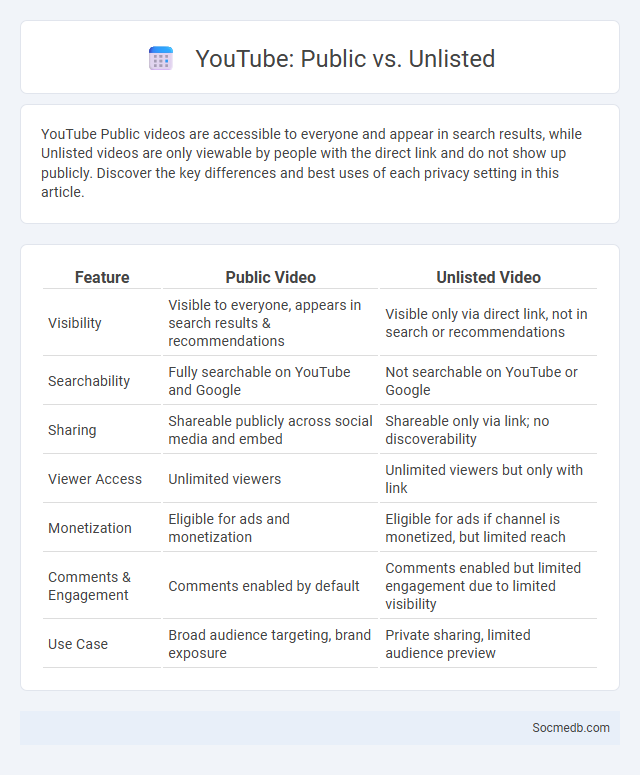
Photo illustration: YouTube Public vs Unlisted
YouTube Public videos are accessible to everyone and appear in search results, while Unlisted videos are only viewable by people with the direct link and do not show up publicly. Discover the key differences and best uses of each privacy setting in this article.
Table of Comparison
| Feature | Public Video | Unlisted Video |
|---|---|---|
| Visibility | Visible to everyone, appears in search results & recommendations | Visible only via direct link, not in search or recommendations |
| Searchability | Fully searchable on YouTube and Google | Not searchable on YouTube or Google |
| Sharing | Shareable publicly across social media and embed | Shareable only via link; no discoverability |
| Viewer Access | Unlimited viewers | Unlimited viewers but only with link |
| Monetization | Eligible for ads and monetization | Eligible for ads if channel is monetized, but limited reach |
| Comments & Engagement | Comments enabled by default | Comments enabled but limited engagement due to limited visibility |
| Use Case | Broad audience targeting, brand exposure | Private sharing, limited audience preview |
Introduction to YouTube Video Privacy Settings
YouTube video privacy settings allow you to control who can view your content, enhancing your channel's security and audience targeting. Options include Public, Private, and Unlisted, each providing different levels of visibility and access permissions for your videos. Managing these settings empowers you to protect your personal information and tailor viewer engagement effectively.
What Is a Public YouTube Video?
A public YouTube video is a content format accessible to anyone on the platform without restrictions, allowing maximum visibility and engagement. You can share it broadly across social networks, embed it on websites, and optimize it with titles, tags, and descriptions for better search ranking. Understanding the public setting ensures that your video reaches a wide audience, driving views and interaction effectively.
What Does ‘Unlisted’ Mean on YouTube?
The term "Unlisted" on YouTube means your video is not visible to the general public or search results but can be accessed by anyone with the direct link. Unlike private videos, unlisted videos allow sharing without needing explicit viewer permissions. This setting provides a balance between privacy and accessibility for content creators managing their social media presence.
Differences Between Public and Unlisted Videos
Public videos on social media platforms are accessible to anyone, searchable via keywords, and often appear in recommendations and trending sections, maximizing visibility and engagement. Unlisted videos, by contrast, are hidden from public search results and can only be accessed by those with the direct link, offering privacy while still allowing controlled sharing. The choice between public and unlisted videos impacts audience reach, privacy settings, and potential interaction metrics such as views, likes, and comments.
Visibility and Accessibility: Who Can Watch Each Type?
Social media platforms vary in visibility and accessibility features, determining who can watch each type of content. Public posts are accessible to anyone, increasing reach and engagement, while private or restricted content limits viewers to approved friends or followers, enhancing privacy. Stories and live streams often include customizable settings, allowing users to control audience access based on individual preferences or platform-specific options.
Searchability and Discoverability on YouTube
YouTube's searchability leverages advanced algorithms analyzing keywords, metadata, and user engagement to rank videos highly in relevant search results. Discoverability is enhanced through personalized recommendations, trending tabs, and optimized thumbnails that increase click-through rates. Creators can improve visibility by using precise tags, detailed descriptions, and engaging content to align with YouTube's SEO best practices.
Sharing and Embedding: How Each Setting Affects Distribution
Sharing settings on social media control the ease with which content is distributed across platforms and directly impact audience reach and engagement levels. Embedding settings determine whether content can be integrated into external websites, influencing its visibility beyond the original platform and expanding the potential for viral dissemination. Optimizing both sharing and embedding permissions enhances content discoverability, drives traffic, and maximizes the content's overall distribution potential.
Best Use Cases for Public vs Unlisted Videos
Public videos on social media maximize reach and engagement by attracting a broad audience, making them ideal for brand awareness, viral marketing campaigns, and content intended to educate or entertain large communities. Unlisted videos offer controlled access, perfect for sharing exclusive content with select groups such as customers, team members, or paying subscribers, ensuring privacy while still enabling easy distribution. You can strategically leverage public videos to build your brand visibility, while using unlisted videos to nurture deeper, more personal connections with targeted audiences.
Privacy and Security Concerns
Social media platforms collect vast amounts of personal data, making privacy and security critical concerns for users. Your sensitive information can be exposed to unauthorized access, data breaches, or misuse by third parties, emphasizing the importance of strong privacy settings and cautious sharing. Implementing two-factor authentication and regularly reviewing app permissions can help safeguard your online presence.
Choosing the Right YouTube Video Setting for Your Needs
Selecting the appropriate YouTube video settings is crucial for optimizing content visibility and viewer engagement. Consider resolution options such as 1080p or 4K to balance video quality and file size, while adjusting privacy settings between public, unlisted, and private to control audience reach. Properly configuring metadata, including titles, descriptions, and tags, enhances searchability and aligns with your social media marketing strategy.
 socmedb.com
socmedb.com